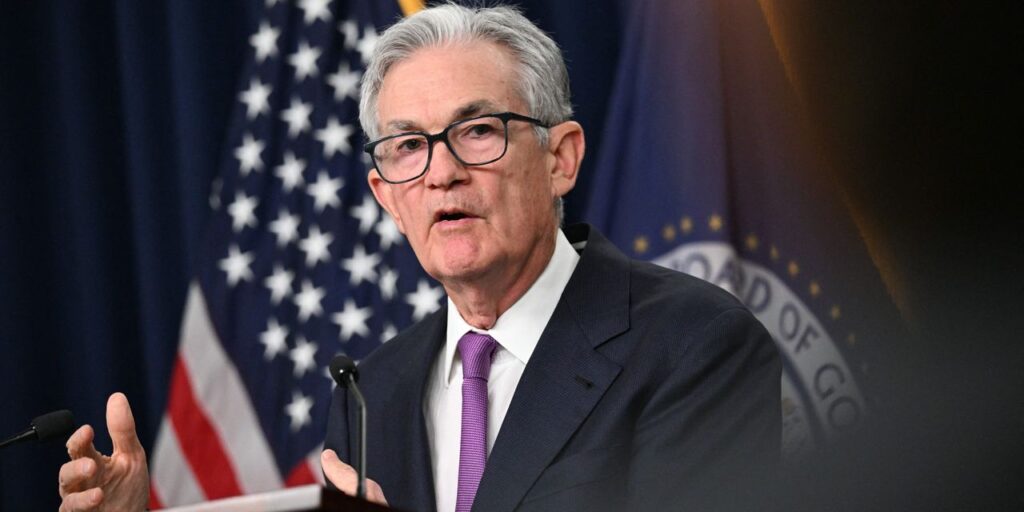Investors will be tuning in to a couple “critical concepts” that may surface Wednesday after the Federal Reserve’s policy meeting, including the extent to which the Fed sees markets doing some of its work tightening financial conditions, according to BlackRock’s Rick Rieder.
“It seems like the Fed has adopted this idea that the markets have done some of the tightening for them,” said Rieder, BlackRock’s chief investment officer of global fixed income and head of the firm’s global allocation investment team, in a phone interview. How Fed Chair Jerome Powell addresses that concept on Wednesday will be “important,” as investors are watching for clues as to whether the central bank sees the need for additional interest rate hikes to soften the labor market in order to slow the economy and bring down inflation, he said.
While goods inflation has been “tackled” by the Fed via its interest rate hikes, prices in services have remained elevated and “sticky,” according to Rieder. That brings another important concept into focus. In his view, the Fed’s “uneven” progress in taming inflation raises questions over Powell’s willingness to be patient as the resilient U.S. economy slowly moderates against the backdrop of a “pretty solid” labor market.
“I personally feel like they shouldn’t try and reduce employment in this country” in a bid to bring down service-level inflation, partly because it’s not just wage growth that’s fueling it, said Rieder. He thinks the Fed should “pause and see how the data manifests itself because the risk of overtightening is significant.”
The Fed’s rate hikes work with a lag and some investors worry that continuing to raise them risks pushing up the unemployment rate and potentially causing a recession.
Rieder expressed concern over the cost of putting people out of work when inflation has broadly decelerated from peak levels while the U.S. economy has shown some signs of slowing, despite the “blockbuster” report on gross domestic product in the third quarter.
Meanwhile in markets, Treasury yields have surged this year and U.S. stocks have slumped for three straight months through October. The Dow Jones Industrial Average
DJIA
and S&P 500
SPX
both just booked their worst October since 2020, while the Nasdaq Composite
COMP
saw its worst October since 2018, according to Dow Jones Market Data.
Rising interest rates and a slumping stock market tighten financial conditions, making it tougher and more expensive for companies to finance themselves in debt and equity markets, said Rieder.
As for “moderating” U.S. economic growth, he anticipates GDP in the fourth quarter may come down “significantly” from an estimated 4.9% annual pace in the third quarter and pointed to improvement in a measure of inflation watched by Powell, core services excluding shelter.
“Core services ex shelter” is running at an annualized 3.2% pace over the past six months through September, down from 8% in September 2022, according to Rieder.
It’s not just wage growth that’s keeping services-related inflation too high, he said, citing “quirky things” like higher insurance prices for health and autos that are not cyclical. “The Fed’s tools aren’t designed to manage insurance pricing,” he said.
Still, Rieder said the accumulative effects of higher rates are being felt in the economy, with consumers “burning down savings,” even as they remain “pretty high,” while credit card balances and delinquencies are rising. He’s been watching the climb in mortgage rates due to concern that a potential overtightening of financial conditions risks hitting the housing market, with residential real estate representing about “three-quarters of people’s wealth.”
Rieder is also monitoring commercial real estate, regional banks and corporate finance markets for pressure created by the recent jump in Treasury yields. In corporate debt markets, large investment-grade companies don’t seem to be facing “much stress at all” as most have termed their borrowings out, but there’s “a bit” of refinancing worry among riskier borrowers in the leveraged loan market, he said.
Meanwhile, the yield on the 10-year Treasury note rose for six straight months through October, surging 1.423 percentage points over that stretch to finish Tuesday at 4.874% based on 3 p.m. Eastern Time levels, according to Dow Jones Market Data. While 10-year yields
BX:TMUBMUSD10Y
have recently retreated, they’re not far off their highest level since July 2007 reached on Oct. 19.
Why buy long-term Treasurys?
Rieder favors Treasurys with shorter durations, saying “you can create an incredible amount of income” at the front end to the belly of the yield curve in areas like U.S. government debt, investment-grade credit and agency mortgages without taking a lot of risk.
“Why do you need to own the long end of the yield curve?” said Rieder. “The long end of the yield curve has more volatility than the equity market,” he said. “It doesn’t give you any more yield than the front end.”
The yield on the two-year Treasury note
BX:TMUBMUSD02Y
was trading around 5.03% on Wednesday morning, while the three-year yields
BX:TMUBMUSD03Y
were at 4.85% and five-year Treasury rates
BX:TMUBMUSD05Y
were trading around 4.75%, according to FactSet data, at last check.
George Catrambone, head of fixed income for the Americas at DWS, said in a phone interview that “based on long-end volatility, I still favor the short end of the curve.” He cited two-year and five-year Treasury rates as examples while saying the Fed is nearing the end of its hiking cycle.
The Fed will probably decide on Wednesday to maintain its “hawkish hold” on interest rates, said Catrambone. But he expects that the central bank will “keep the threat of a rate hike on the table,” as it will want to “prevent the market from pricing in rate cuts into next year’s forecast” and would like to keep financial conditions tight in order to bring inflation down to its 2% target.
Investors are waiting for the Fed to release its decision on rates at 2 p.m. Eastern time Wednesday, with Powell scheduled to hold a press conference on monetary policy at 2:30 p.m.
Read the full article here

